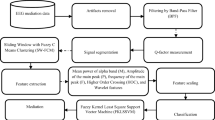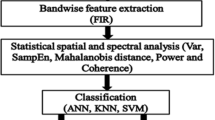Abstract
Self-confidence is one’s own belief of success with respect to a specific task. Cognitive tasks like decision making, problem solving etc. are influenced a lot by our self-confidence level. Recent studies show possibility of assessing self-confidence level from brain activation patterns. Here, we are proposing a novel metric based on brain signals acquired by Electroencephalogram (EEG) for quantification of self-confidence level of an individual. The EEG signal is recorded using a low cost, low resolution EEG device. Most significant EEG features (with p value <0.05) have been identified and used for formulating a metric for self-confidence level. Training data is refined using Random Sample Consensus (RANSAC) method to remove the outliers. With these stable training data, reference clusters for low and high confidence categories have been formed based on the most significant features. These reference clusters are used thereafter to compute the confidence level quantitatively for the test participants. Results show that the proposed metric can classify low and high self-confidence levels satisfactorily. Thus, the proposed metric provides a quantified measure of self-confidence level with which a task is performed. The metric can also be used in various applications like confidence measurement in academic settings, online tests, cognitive assessment, rehabilitation, therapy design.






Similar content being viewed by others
References
Atherton S, Antley A, Evans N, Cernis E, Lister R, Dunn G, Freeman D (2016) Self-confidence and paranoia: an experimental study using an immersive virtual reality social situation. Behav Cogn Psychother 44(1):56–64
Babiker A, Faye I, Mumtaz W, Malik AS, Sato H (2019) EEG in classroom: EMD features to detect situational interest of students during learning. Multimed Tools Appl 78(12):16261–16281
Bell AJ, Sejnowski T (1995) An information-maximization approach to blind separation and blind deconvolution. Neural Comput 7(6):1129–1159
Bénabou R, Tirole J (2002) Self-confidence and personal motivation. Quarterly J Econ 117(3):871–915
Betz NE, Borgen FH (2010) The CAPA integrative online system for college major exploration. J Career Assess:317–327
Boldt A, Yeung N (2015) Shared neural markers of decision confidence and error detection. J Neurosci 35(8):3478–3484
Bornstein BH, Douglas JZ (1999) "I know I know it, I know I saw it": The stability of the confidence–accuracy relationship across domains. J Exper Psychol: Appl 5(1):76
Brannan JD, White A, Bezanson JL (2008) Simulator effects on cognitive skills and confidence levels. J Nurs Educ 47(11):495–500
Cheng H, Furnham A (2002) Personality, peer relations, and self-confidence as predictors of happiness and loneliness. J Adolesc 25(3):327–340
Clark MM, Warren BA, Hagen PT, Johnson BD, Jenkins SM, Werneburg BL, Olsen KD (2011) Stress level, health behaviors, and quality of life in employees joining a wellness center. Am J Health Promot 26(1):21–25
Crocker J, Brenda M (1989) Social stigma and self-esteem:the self-protective properties of stigma. Psychol Rev 96(4):608–630
Edward L Thorndike, Irving Lorge, “The teacher’s wordbook of 30,000 words. new york: Columbia university, teachers college,” 1944
Elfering A, Grebner S (2011) Ambulatory assessment of skin conductivity during first thesis presentation: lower self-confidence predicts prolonged stress response. Appl Psychophysiol Biofeedback 36(2):93–99
Feltz, D. L. “Self-confidence and sports performance” In Essential readings in sport and exercise psychology, Human Kinetics, 2007, pp. 278–294.
Flaskerud JH (1988) Is the Likert scale format culturally biased. Nursing Res
Flavell JH (1979) Metacognition and cognitive monitoring: A new area of cognitive–developmental inquiry. Am Psychol 34(10):906
Fleming SM, Huijgen J, Dolan RJ (2012) Prefrontal contributions to metacognition in perceptual decision making. J Neurosci 32(18):6117–6125
Galán FC, Beal CR (2012) EEG estimates of engagement and cognitive workload predict math problem solving outcomes. In: International conference on user modeling, adaptation, and personalization. Springer, Berlin
Gao Q, Wang CH, Wang Z, Song XL, Dong EZ, Song Y (2020) EEG based emotion recognition using fusion feature extraction method. Multimedia Tools Appl:1–18
Gavas, R., Chatterjee, D., & Sinha, A., “Estimation of cognitive load based on the pupil size dilation” In 2017 IEEE International Conference on Systems, Man, and Cybernetics (SMC), 2017, pp. 1499–1504.
Hermans D, Engelen U, Grouwels L, Joos E, Lemmens J, Pieters G (2008) Cognitive confidence in obsessive-compulsive disorder: distrusting perception, attention and memory. Behav Res Ther:98–113
Kepecs A, Uchida N, Zariwala HA, Mainen ZF (2008) Neural correlates,computation and behavioural impact of decision confidence. Nature 455(7210):227–231
Kiani R, Shadlen MN (2009) Representation of confidence associated with a decision by neurons in the parietal cortex. Science 324(5928):759–764
Lempert KM, Chen YL, Fleming SM (2015) Relating pupil dilation and metacognitive confidence during auditory decision making. PLoS One 10(5):1–12
Liapis A, Katsanos C, Sotiropoulos DG, Karousos N, Xenos M (2017) Stress in interactive applications: analysis of the valence-arousal space based on physiological signals and self-reported data. Multimed Tools Appl 76(4):5051–5071
Mayzner MS, Tresselt ME (1958) Anagram solution times: a function of letter order and word frequency. J Exp Psychol 56(4):376–379
McKay JM, Selig SE, Carlson JS, Morris T (1997) Psychophysiological stress in elite golfers during practice and competition. Austral J Sci Med Sport:55–61
Robazza C, Gallina S, D'Amico MA, Izzicupo P, Bascelli A, Di Fonso A, Di Baldassarre (2012) Relationship between biological markers and psychological states in elite basketball players across a competitive season. Psychol Sport Exerc 13(4):509–517
Ruzgiene B, Förstner W (2005) Ransac for outlier detection. Geodesy Cartogr 31(3):83–87
Sander P, Sanders L (2003) Measuring confidence in academic study: a summary report. Electron J Res Educ Psychol Psychoped 1(1):1–17
Sinha A, Gavas R, Chatterjee D, Das R, Sinharay A (2015) Dynamic assessment of learners' mental state for an improved learning experience. In: 2015 IEEE frontiers in education conference (FIE), pp 1–9
Sowislo JF, Orth U (2013) Does low self-esteem predict depression and anxiety? A meta-analysis of longitudinal studies. Psychol Bull 139(1)
Stankov L (2013) Noncognitive predictors of intelligence and academic achievement: an important role of confidence. Personal Individ Differ 55(7):727–732
Stankov L, Crawford JD (1997) Self-confidence and performance on tests of cognitive abilities. Intelligence 25(2):93–109
Stankov L, Lee J (2008) Confidence and cognitive test performance. J Educ Psychol 100(4):961–976
Stankov L, Kleitman S, Jackson SA (2015) Measures of the trait of confidence. In: Measuresof personality and social psychological constructs. Academic Press, pp 158–189
Williams JM, Krane V (1992) Coping styles and self-reported measures of state anxiety and self-confidence. J Appl Sport Psychol 4(2):134–143
Zhang Y, Zhang S, Ji X (2018) EEG-based classification of emotions using empirical mode decomposition and autoregressive model. Multimed Tools Appl 77(20):26697–26710
Author information
Authors and Affiliations
Corresponding author
Additional information
Publisher’s note
Springer Nature remains neutral with regard to jurisdictional claims in published maps and institutional affiliations.
Rights and permissions
About this article
Cite this article
Chatterjee, D., Chowdhury, A., Gavas, R. et al. Real time estimation of task specific self-confidence level based on brain signals. Multimed Tools Appl 80, 19203–19217 (2021). https://doi.org/10.1007/s11042-021-10676-8
Received:
Revised:
Accepted:
Published:
Issue Date:
DOI: https://doi.org/10.1007/s11042-021-10676-8




